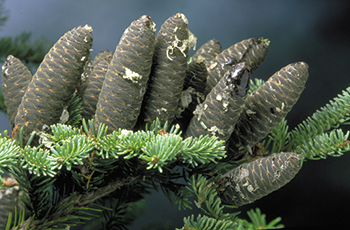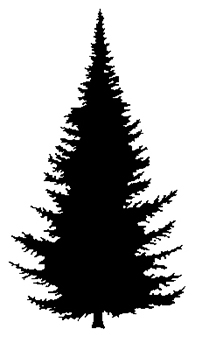New Brunswick's provincial symbols
One of Canada’s three Maritime Provinces, New Brunswick is constitutionally bilingual. While the majority of the population speaks English, there is also a large Francophone minority – mostly of Acadian origin.
Origin of the name
New Brunswick was named in 1784 to honour the reigning British monarch, King George III, who was also Duke of Brunswick.
Population (2006): 749,200
Area: Land – 72,090 km2Fresh water – 1,350 km2Total – 73,440 km2Capital: FrederictonDate of entry into Confederation: July 1, 1867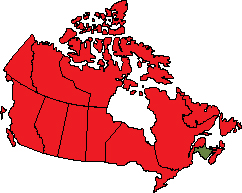
History
The area now known as New Brunswick was originally inhabited by nations of the Algonquian linguistic group. The Mi’kmaq welcomed the French under Pierre Du Gua de Monts and Samuel de Champlain when they first landed in New Brunswick in 1604. The relationship between the First Nations and the French was good from the start. The Mi’kmaq helped the French settlers, who became known as Acadians, adapt to the land. They also helped French troops launch raids on New England.
The Acadians were the first Europeans to settle in present-day New Brunswick. Until the Treaty of Utrecht in 1713, when France signed over the area to Great Britain, both Nova Scotia and New Brunswick were part of Acadia. However, over the years, France had all but ignored the Acadians, being much more concerned with New France and the increasing value of the fur trade there.
The Treaty of Utrecht created the British colony of Nova Scotia, which at that time included New Brunswick and Prince Edward Island. Nevertheless, Acadia continued for many years to be an area of conflict between the old world powers, and it was decades before the area was fully brought under British rule. After the British victory, many Acadians fled; others were expelled by the authorities in 1755.
In 1762, a trading community was established by Massachusetts merchants at the mouth of the Saint John River. Before the peace of 1763, permanent British settlements were started by New Englanders at Chignecto and in the Saint John River Valley. Settlers from Yorkshire, England, who came to Chignecto in the early 1770s, helped defeat an attempt from the rebellious colonies in 1776 to take Chignecto and its strategic Fort Cumberland/Beauséjour.
In 1783, thousands of Loyalist refugees from the American Revolution settled in the western part of Nova Scotia, far from the colony's administrative centre in Halifax. In response to Loyalist demands for their own colonial administration, the British government established the new colony of New Brunswick in 1784.
In 1864, New Brunswick was involved in discussions with the colonies of Nova Scotia, Prince Edward Island and Newfoundland to consider a Maritime union when the Province of Canada was issued an invitation to attend the Charlottetown Conference. The result was the creation of the Dominion of Canada three years later.
New Brunswick was among the first four provinces to form the Dominion of Canada at Confederation on July 1, 1867. Promises of increased prosperity, a railway linking New Brunswick to central Canada, and a desire to unite with other British colonies to form a strong country in the face of growing American influence, all encouraged New Brunswick to join Confederation.
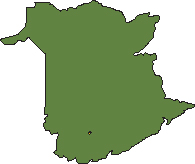
Coat of arms
The shield of New Brunswick's coat of arms was granted by Queen Victoria in 1868. The crest and supporters were granted and the motto confirmed by Queen Elizabeth II in 1984, to honour the 200th anniversary of New Brunswick's creation.
The upper third of the shield is red with a gold lion, symbolizing New Brunswick’s ties to Britain. The lion is also found in the arms of the Duchy of Brunswick in Germany, the ancestral home of King George III. The lower part of the shield displays an ancient galley, most probably a reflection of the importance of shipbuilding and seafaring to New Brunswick in the 19th century. The galley is also based on the design of the province's original great seal, which featured a sailing ship on water.
The shield is supported by two white-tailed deer wearing collars of wampum. From one collar is suspended the Royal Union Flag, from the other the arms of Royalist France, to indicate the province's British and French background. Today, New Brunswick is Canada's only officially bilingual province.
The crest above the shield features an Atlantic salmon leaping from a coronet of gold maple leaves and bearing St. Edward’s Crown on its back. The coat of arms’ base is a grassy mound with fiddleheads and purple violets, the provincial floral emblem.
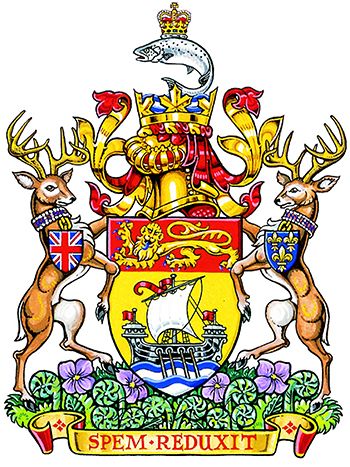
Motto
Spem reduxit (Hope restored)
Flag
The design for the New Brunswick flag is based on the provincial coat of arms, assigned by royal warrant of Queen Victoria in 1868. The provincial flag was adopted by proclamation in 1965.
New Brunswick takes its name from the Duchy of Brunswick in Germany, which in 1784 – the year the province was established – was in the possession of King George III. The arms of Brunswick consist of two gold lions on a red field, and the arms of the King contained the three gold lions of England. The gold lion in the flag therefore reflects New Brunswick's relationship both to the Duchy of Brunswick and England. The galley is the conventional heraldic representation of a ship and reflects the two principal economic activities, shipping and shipbuilding, carried on in New Brunswick when the coat of arms was assigned.
The flag's proportions are four by length and two and one-half by width.
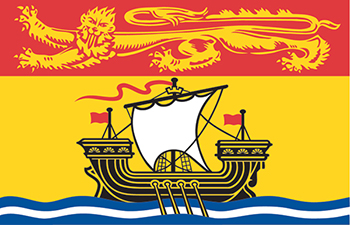
Floral emblem
The purple violet (Viola cucullata) was adopted as New Brunswick’s official flower in 1936, based on input from the Women’s Institute, the Lieutenant Governor and the province’s schoolchildren.
The flowers of the purple violet have been used in jams and syrups, and are believed to have properties to soothe the digestive tract and suppress a cough.
A relative of the pansy, the violet can be purple or dark blue – it is also known as the marsh blue violet. Found throughout Eastern Canada – particularly in wet meadows and woodlands – these violets are stemless, with leaves and flower stocks growing directly from rootstocks. The purple violet grows especially well in New Brunswick and is seen in fields, lawns and gardens in the early summer.
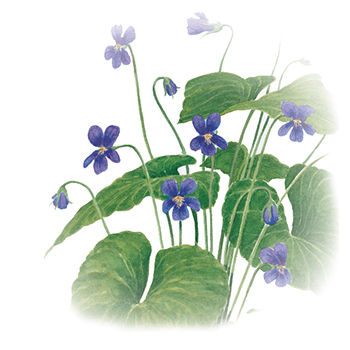
Other provincial symbols
Bird
The black-capped chickadee (Poecile atricapillus) was adopted as a provincial bird in 1983, based on a contest run by the New Brunswick Federation of Naturalists.
Small and energetic, the chickadee’s distinctive song is often heard throughout the year. Another high‑pitched song is sung to welcome the arrival of spring.
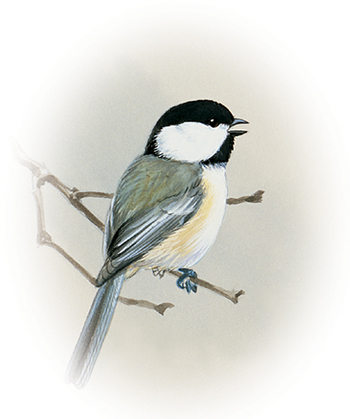
Fishing fly
An Atlantic salmon fly – designated as the “Picture Province” – was proclaimed to be an official provincial symbol in 1993.
Designed by Warren Duncan, each of the fly’s colours are symbolic: a tag of gold symbolizes the value of Atlantic salmon to New Brunswick; a butt of green floss honours the fiddlehead; a tail of red goose fibres to match Canada's flag indicates New Brunswick's ties with the nation; a body of cranberry red is representative of New Brunswick’s official colours; a hackle of lemon yellow matches the background colour of New Brunswick’s flag; and the wing of hair and head of black represents the black bear.
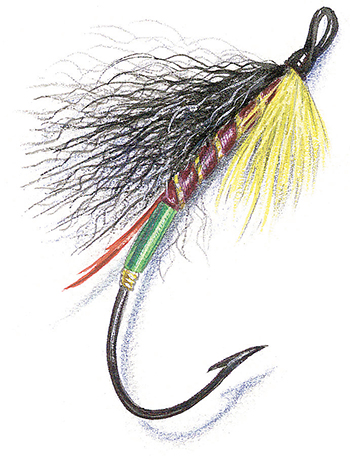
Official soil
The most prevalent soil type in New Brunswick, the Holmesville Soil Series was named the official, provincial soil in 1997.
The Holmesville Soil is a fertile soil that provides high yields of both agriculture and forest crops.
A sandy loam-to-loamy soil with less than 20 per cent clay and 15-30 per cent coarse fragments, the parent material of the soil is a moderately compact glacial till. Holmesville is located in Carleton County near Florenceville.
Tartan
Designed by the Loomcrofters of Gagetown, the New Brunswick tartan was officially adopted in 1959 and registered at the Court of the Lord Lyon, King of Arms of Scotland.
Each of the colours within the tartan’s design is symbolic of a different element of New Brunswick: forest green represents lumbering; meadow green represents agriculture; blue represents coastal and inland waters; gold represents the province’s potential wealth; and red represents the devotion of the early Loyalists settlers and the Royal New Brunswick Regiment.
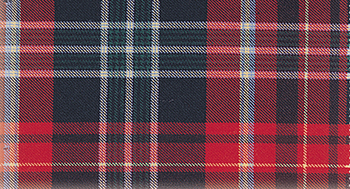
Tree
New Brunswick adopted the balsam fir (Abies balsamea) as its official tree in 1987. Best recognized as a Christmas tree, the balsam fir can grow up to 20 metres high (65 feet). A staple of the province’s lumber industry, the tree’s unusually long wood fibres are perfect for making high-quality paper.
